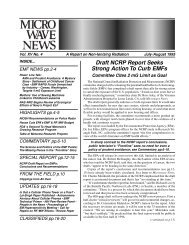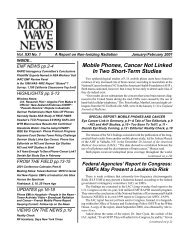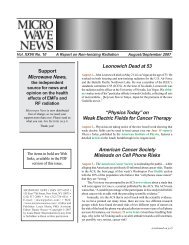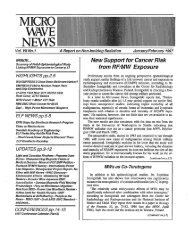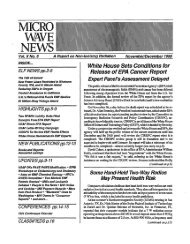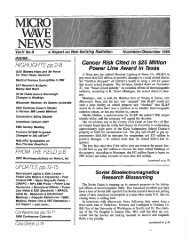Create successful ePaper yourself
Turn your PDF publications into a flip-book with our unique Google optimized e-Paper software.
EMF NEWS<br />
EMF exposure stimulated transient increases in ODC activity<br />
in vitro (see <strong>MWN</strong>, N/D87).<br />
The Finnish researchers used the experiment to test the<br />
hypothesis that increased ODC activity might explain why<br />
6<br />
RF Exposure and Brain Tumors in U.S. Air Force<br />
U.S. Air Force personnel exposed to RF/MW radiation had a<br />
39% elevated risk of brain tumors, according to a study by Dr. J.<br />
Kevin Grayson of the Armstrong Laboratory at Brooks Air Force<br />
Base, TX. Grayson also found that exposure to low-frequency EMFs<br />
was linked to an increased brain cancer risk of 28%. Both results<br />
are of borderline statistical significance.<br />
“This result could easily be explained in terms of bias,” Grayson<br />
said in an interview. “This study is just a baby step—but you’ve got<br />
to start somewhere.”<br />
Grayson’s research, published in the March 1, 1996, American<br />
Journal of Epidemiology, was carried out in response to concern among<br />
Air Force personnel about the relationship between cancer and RF/<br />
MW radiation from various kinds of electronic equipment, as well<br />
as EMFs from power lines and VDTs. He noted that, although there<br />
have been many occupational studies of EMFs and brain cancer,<br />
“Few epidemiologists have attempted to examine the association<br />
between exposure to [RF/MW] fields and brain tumor risk.”<br />
On-the-job exposure to low levels of ionizing radiation was not<br />
associated with an increased likelihood of brain cancer. Possible<br />
interactions between different types of fields were analyzed, but no<br />
increase in risk was found. Grayson concluded that the latter result<br />
“calls into question the role of extremely-low-frequency EMFs as a<br />
tumor promoter.”<br />
The study examined 230 cases of brain cancer from hospital<br />
records for 880,000 active-duty Air Force personnel. The data were<br />
from military records only; Grayson did not attempt any followups<br />
on those who had left the service.<br />
Exposure assessment was based on a job-exposure matrix, which<br />
drew on various sources. Overall, Grayson described exposure estimation<br />
as one of his study’s main limitations. “The only recommendation<br />
I could make from here is that we do a prospective study<br />
and measure actual exposures,” he said. “That’s extremely expensive,<br />
but we’re not going to have the answers until we do that.”<br />
A strong relationship was found between senior military rank<br />
and the chance of brain cancer. Grayson did not offer any explanation<br />
for this result, other than citing previous findings of an increase<br />
in risk at higher levels of socioeconomic status.<br />
In a related paper in the February 1996 Aviation, Space and Environmental<br />
Medicine, Grayson and Dr. Terence Lyons, also of the<br />
Armstrong Lab, reported a higher incidence of certain cancers among<br />
flying than among nonflying officers in the U.S. Air Force. This study<br />
did not examine possible effects of EMFs and RF/MW radiation.<br />
No EMF Effect on Overall Mortality<br />
In a study of 22,000 utility workers at Hydro-Québec, researchers<br />
at McGill University in Montreal, Canada, found no increase in<br />
overall mortality among those with relatively high EMF exposures.<br />
But they cautioned that “small numbers and approximate exposure<br />
assessments preclude the denial of any risk, in particular if it were<br />
to affect a rare cause of death.”<br />
Writing in the January 1996 issue of Occupational and Envi-<br />
Epidemiology Roundup<br />
magnetic fields promote cancer. But the data did not support<br />
this. On the contrary, the team found that the effects of longterm<br />
magnetic field exposure were independent of those of high<br />
ODC activity.<br />
ronmental Medicine, Drs. Dalsu Baris, Ben Armstrong, Jan Deadman<br />
and Gilles Thériault explained that they conducted this study because,<br />
“Nearly all epidemiological studies have focused on cancer,<br />
with no attention given to other causes of death.” They analyzed<br />
data from a cohort of Hydro-Québec employees that was used in their<br />
earlier Canadian–French study of occupational EMF exposure and<br />
cancer risk (see <strong>MWN</strong>, M/A94 and N/D94).<br />
They did find a significant doubling of risk of death by accident<br />
or violence among workers with higher EMF exposures, part of which<br />
was attributable to electrocutions. In addition, Baris and coworkers<br />
saw some nonsignificant associations between EMF exposure and<br />
leukemia, brain cancer and suicide, and between pulsed EMFs and<br />
lung cancer.<br />
Comparisons of utility workers with the general population—<br />
using standardized mortality ratios (SMRs)—showed that utility<br />
employees had generally lower death rates than the population as a<br />
whole. The research team attributed this finding to the “healthy<br />
worker effect”—the fact that those who hold a regular job are healthier,<br />
on average, than those who do not. Drs. David Savitz and Dana<br />
Loomis drew similar conclusions about SMR comparisons in their<br />
study of 139,000 American utility workers, which found an EMF–<br />
brain cancer connection (see <strong>MWN</strong>, J/F95).<br />
Baris and his coworkers cautioned that the weak associations<br />
they observed may have been understated, due to potential biases<br />
in their study. But despite this uncertainty, they concluded, “These<br />
results are broadly reassuring that major causes of death are not strongly<br />
associated with exposure to electric and magnetic fields.”<br />
EMF–Suicide Link Not Strong<br />
Baris’s team at McGill also analyzed the relationship between<br />
death by suicide and EMF exposure, using data from the same cohort<br />
of Hydro-Québec utility workers.<br />
Several earlier studies of residential exposure to power line EMFs<br />
had found an association with increases in suicides and/or symptoms<br />
of depression, although one other residential and two occupational<br />
studies found no such link (see <strong>MWN</strong>, M/J88, J/A92 and M/A94,<br />
and Baris’s companion article in the January 1996 Occupational<br />
and Environmental Medicine).<br />
The McGill researchers explained what might cause such a connection:<br />
EMFs have been found to reduce the production of melatonin hormone<br />
by the pineal gland and disturb its circadian rhythm. There is<br />
substantial evidence that disruption in the normal circadian rhythm of<br />
pineal melatonin secretion is associated with depression.<br />
After examining the Hydro-Québec data, Baris’s group found<br />
“mostly small, nonsignificant increases” among workers with higherthan-normal<br />
cumulative EMF exposure. One out of ten indices of EMF<br />
exposure did show a significant rise in the suicide rate, and this did<br />
not seem to be explained by confounding factors such as alcohol<br />
use and marital status. But the team did not put much weight on this<br />
finding, noting that this index had not been identified in advance as<br />
being more relevant than the others, and there was no evidence of a<br />
dose–response relationship. The researchers also noted that there were<br />
MICROWAVE NEWS March/April 1996



